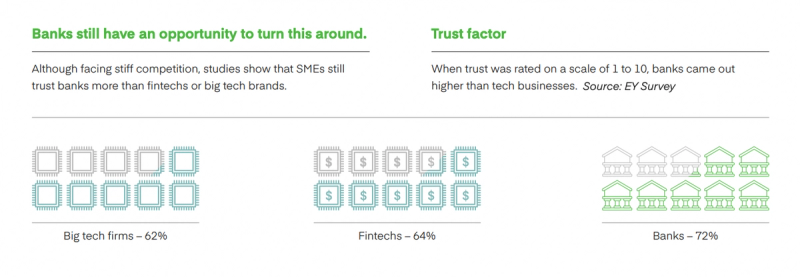Early on in Unlocking big growth in small businesses, it looks clear that small and medium sized businesses represent the backbone of the global economy, raking up approximately 90% of all business worldwide.
For such an economic powerhouse - operating across all categories - one would expect a line of ad-hoc services, ready to facilitate, cater for and partake in the activities of a diverse and vibrant sector. But the truth is that SMEs' ever-changing landscape and their fluid needs have been chronically underserved for decades.
Looking at it from a financial perspective, it’s clear banks and lending institutions have squeezed SMEs among products and services that were either aimed at large corporations or targeting retail consumers. Neither befitting or benefitting SMEs’ needs, and rather making it harder to succeed.

It’s no surprise that Big Tech and non-traditional players identified the gap in the market when banking conglomerates didn’t. They had the flexibility or technology to invest in SMEs, so much so that fintechs and tech giants like Amazon invested $1 trillion in small business loans in 2021 alone.
The report highlights how 34% of SMEs, despite signalling dissatisfaction with their banking experiences, still consider banks the most trusted partner for financial services. But for how long?
According to the report, developed by Mambu in association with EY, there are three main challenges that have defined the relationship between SMEs and banks and lenders:
- SMEs’ ROI for financial institutions is lower than ROI for corporate or retail
- Banks don’t understand the multifaceted nature of the small and medium size businesses - most don’t have an SME division
- With higher default rates, SMEs are risky business banks - who are notoriously risk averse.
So in order to capture lucrative growth opportunities offered by underserved SMEs, the report urges banks to first recognise the segment’s unique needs and then respond with flexible and hyper-relevant products and support.
Building knowledge with customer relationships, focusing on a specific segment, including SMEs into their ecosystem and creating smooth digital experiences by leveraging next-gen core platforms are all key to unlock growth opportunities for SMEs and get a slice of the pie in return.

In this perspective, technology is the one no-brainer pillar onto which banks can lay out the foundation for mutual growth. It will however present banks with a series of questions: build or buy tech components to better serve SMEs? Launch a new side business to tackle the market, or transition incrementally? The report highlights how financial institutions need to look at their legacy tech stack and address what’s doing for them. They need to enhance the flexibility of their products and services.
True transformation for banks means having the ability to harness the power of technology to transform operations at scale as well as the ability to provide the products and services the customer demands.
Competition is increasing and niches that are left untouched are being filled by digital innovators forcing financial organisations to improve their technical capabilities. So how can you profit from SME lending transformation with product innovation? Find out more in Unlocking big growth in small businesses.
